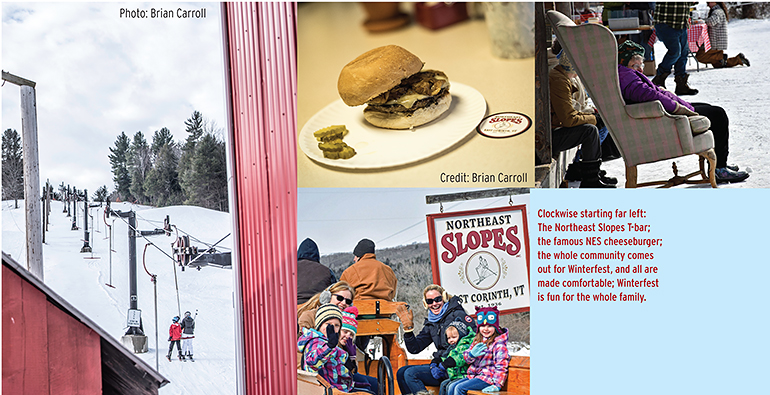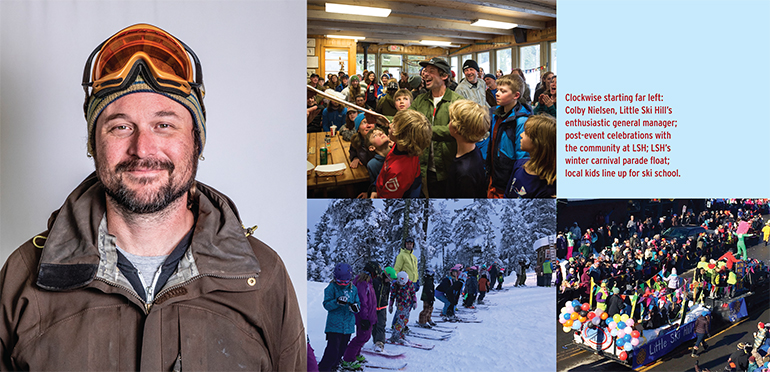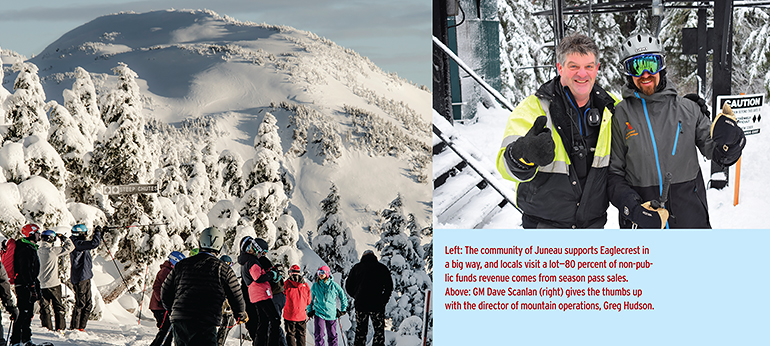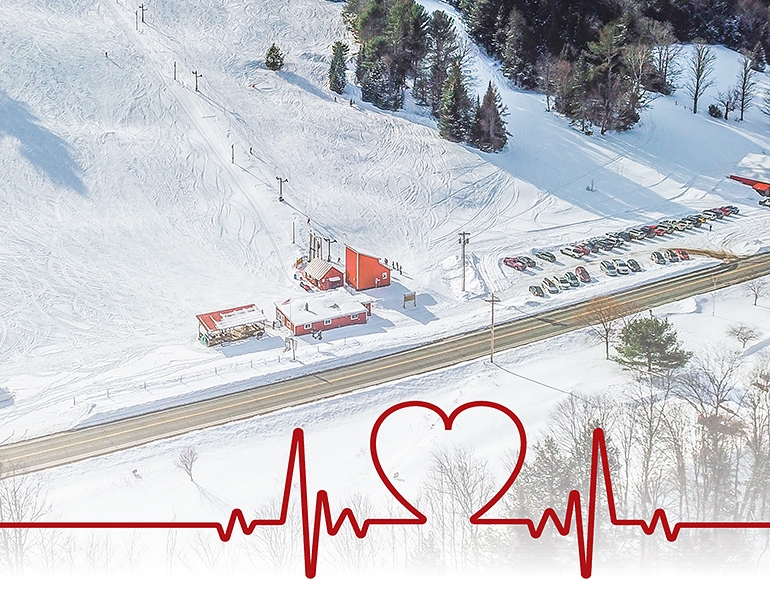Scattered about the winter sports world are special little hills that you may never have heard of. On a topographical map, they may barely make a blip. But in the communities they center, they stand tall: not just a hill with trails carved out, but a true central spot for activity, socializing, bonding, and making a difference. They are very much part of life around them—the heartbeat of their communities. Call them “heartbeat hills.”
Proof positive? All are supported to a large degree by the community itself, whether by tax dollar support, local fundraising, volunteerism, or a combination of all three.
SAM visited with three such spots, one looking to expand for the sake of its future, one serving as a kind of grow-with-me community for all, and another depending totally on local volunteers to operate. All have, in their own way, something to teach the big hills. See for yourself.
NORTHEAST SLOPES
ALL-VOLUNTEER ARMY
The instructions for booking a ski lesson at Northeast Slopes in Corinth, Vt., say a lot about just how this local hill runs. “For ski school sign up, please see the kitchen staff.”
Totally run by volunteers, the area chugs along and is a beloved part of the community. The staff run a rope tow and a T-bar, allowing skiers and riders to access 12 trails on 35 skiable acres with 360 feet of vertical. It’s small, but a giant in the eyes of the community.
An 11-member board of directors oversees the big picture. On the hill and in the base lodge, locals lend their talents and time to keep things running. Ellen (along with her friend Pearl) loves to cook. She oversees the kitchen and brings in other volunteer staff to help. Lift operators are trained the same day as the annual ski swap, and fill in their names on a public Google calendar whenever they can give a few hours to help. A retired resort snow groomer with 45 years’ experience helps oversee that work.
“We all know our jobs and we do them,” says NES vice president Wade Pierson. As a longtime loyalist and lover of the hill, he—like so many locals—felt the calling to step up and keep the place running well. His love of skiing, community, and passion for the ski area’s history drives him to do so.
NES was founded on a handshake between a local ski club president and a farmer back in 1936. (The rope tow dates back to then, and is among the oldest still-operating lifts in the nation). NES struggled a bit in the ’70s and ’80s but made it through, Pierson says, on the dedication and passion of the community at large.

TOWN CENTER
“This is a centerpiece of our town,” he says. “We try to reach out to non-skiers, too, and host events for them [such as the popular annual music festival]. That event alone funds our entire local youth ski program. It raises enough for every middle school kid here to get an equipment lease for the season and seven Friday-afternoon two-hour lessons.”
Locals are proud of the rope tow because of its place in skiing history as “the longest continually operating rope tow in North America,” transporting guests up the hill every winter since 1936.
“I’d take a hacksaw to the T-bar before I’d let that rope tow go,” Pierson says. NES sells leather work-gloves in the base lodge for $8 so the uninitiated don’t ruin their own gloves.
The kitchen is a big draw, and locals like to crow that the burger is legendary. It’s got the right ingredients: locally-raised beef, custom ground into six-ounce patties, served on buns from a local bakery, and smothered in Cabot cheddar. Glen Plake, who came to ski the rope tow and experience the vibe during one of his Down Home tours, called it the best burger he’d ever had—and at $6, it even beat out one he had in France that cost $30.
NES is open on weekends and holidays, as well as Wednesday afternoons for public ski and snowboard lessons. There’s also the annual Skiquinox, which takes place on the night of the brightest full moon of the season. Hundreds of locals show up to ride the rope tow and take runs in the moonlight. It’s not an official event, but it’s been going on for at least four decades. “We just love it,” Pierson says.
The operating schedule varies for other reasons as well. For example, on occasion there are not enough volunteer lifties on hand to get the place going.
“When that happens we just tweak our hours,” Pierson says. “Everyone understands. I’ve never had any complaints. Sometimes when I arrive I see tire tracks in the lot, so I know someone came and knew to just come back later. Think Vail Resorts could get away with that?”
LITTLE SKILL HILL
LOCALLY LOVED SINCE 1937
On any given afternoon you’ll find a whopping 20 percent of the town of McCall, Idaho, on the trails of Little Ski Hill. It’s been that way pretty much since 1937, when a local resident founded the hill to share his love of skiing with his community. Today, that spirit lives on. With scholarship programs, a robust after-school program that buses kids there, and a community that pumps donor funds into it, Little Ski Hill is the consummate Heartbeat Hill.
“Our main audience is kids,” says Little Ski Hill general manager Colby Nielsen. “And has been for years. We are a community hub.”
Nielson should know. He grew up via the Little Ski Hill programs, with memories of racing, learning, and just plain hanging out at the ski area with friends a big part of his life.
For generations, Little Ski Hill has been the center of winter activity in McCall, and residents love it. Volunteers help with maintenance, oversight, and fundraising. They are currently working on a $500,000 capital campaign to support their hill for the coming 50 years. The current capital campaign is in its second half and will, they hope, get them a new T-bar and lights on the hill.
What motivates them? Tradition, a passion for winter sports, and understanding how vital the hill is to their community. These feelings are instilled starting at a young age as kids are given a sense of belonging. “We get to know all the kids,” says Nielsen. “This is a super safe place. Parents can drop their kids off and go and feel totally comfortable with that.”

Another bonus is literally watching kids “grow up” with the Hill’s programs. “Kids getting to the point of working here is a really big part of our program,” Nielson says. “They come in as learners and work their way up and then, in high school, can be instructors.
“I think we do a pretty great job of creating new leaders out there in the world. We give kids a chance to have a mentor and learn from them and then, later, be that mentor.”
That kind of flow creates a spot where families share the same experiences and memories over many generations. “There are folks around here who learned here in the ’40s and ’50s, and now they have yet another generation of family members doing the same thing,” he says.
Funds from the heart. Funding for the resort comes mostly from the town via a local options tax that community programs can apply for annually. Still, it can be a challenge to meet the Hill’s mission: to keep costs super low so that all can afford to ski and ride.
Donors supplement the public fund. Some “sponsor a skier.” The annual Snow Ball boosts the cash flow. And Friday night dinners contribute as well. Each week, a local restaurant donates food, and locals come to hang out in the base lodge and enjoy a fun dinner for a low price. All proceeds go to the area. Nielson started the concept—his parents own a restaurant in the area, so the first ask was easy—but the town picked up on it right away, and it is now a vibrant program.
Little Ski Hill’s finances haven’t always been so sound. “There were some tough times in the 1980s and 1990s, but we made it through,” Nielson says. “There are, fortunately, loud enough dedicated voices saying, ‘We’ve got to keep this going,’ and people are listening.” With the hoped-for capital improvements, he says, the Hill will be able to light up the terrain park, spruce up some other things, and hopefully bring in more guests and therefore, more revenue.
“What we have is perfect right now,” he says. “We just have to work at keeping the cost low and keeping things running well. Our main goal is accessibility, but that also makes it hard to raise prices. We try to remember that and work hard on it. This community loves this hill. It’s a big part of life here.”
EAGLECREST SKI ARFA
GROWING TO STAY LOCAL
Eaglecrest Ski Area in Juneau, Alaska, is more expansive than most town-run hills. It has a 1,620-foot vertical drop and 650-plus skiable acres. But the way it centers its community, the way it is funded, and the way locals feel an ownership of it make Eaglecrest a Heartbeat Hill.
Connected to the community. “There’s extreme support here,” says GM David Scanlan. “Our community is really passionate about Eaglecrest. For many, it’s the reason they chose to live in Juneau. It’s such a gathering place, you can see why it gets that love.”
Witness the “sweat equity” locals love to put into the place. “The availability we have of skilled users to help us with projects is amazing,” says Scanlan. And that, he says, leads to donations, as well as financial support from the city. “They see how hard we all work. This is very much a blood, sweat and tears operation.”
Eaglecrest relies on tax dollars for much of its operational costs. And yet, even in rough financial years, the city steps up and keeps Eaglecrest running. Aside from the public funds, a whopping 80 percent of other revenue comes from season passes. The community supports Eaglecrest well.
Because the area is community-run and -supported, Scanlan has an open door policy for folks to share their compliments or complaints—a practice he brought with him three years ago from his prior post at Mount Abram in Maine, another local hill.
“That accessibility we have to the customer really makes a difference,” he says. “We have an openness and desire to engage with people. And honestly, you could not find a more supportive community than ours.”
Summer to support winter. Now, with Juneau a hot spot for cruise ships each summer, Eaglecrest is looking to invest in activities that will draw some of the roughly 1.2 million cruise visitors and increase revenues exponentially.

Eaglecrest is owned by the City & Borough of Juneau, and operates on a 70 percent cost recovery model. The city subsidizes Eaglecrest with an annual $950,000 General Fund Obligation. This model has endured for decades, but budgets are being stressed on state and local levels. That makes finding funds to replace lifts and upgrade snowmaking a huge challenge. Hence the pursuit of summer operations to ensure the ski area’s long-term financial sustainability. Eaglecrest has to become more to maintain the “less” that locals love.
“Our financial needs, coupled with climate change, has really led us to coming up with a plan,” Scanlan says. “The last five to six winters here have been challenging for us, so it’s hard to make a plan based just on winter.”
The area’s summer master plan would transform it into a year-round adventure park with skiing, mountain biking, a gondola, zip lines, mountain coaster, and more. The gondola will be the first one at an Alaska resort, if approved.
This plan, Scanlan says, will ensure that Eaglecrest will serve the city year round and—if the plan goes as hoped—be self-funding. It’s possible the summer business could prove lucrative enough to fund other city programs, too.
The cost of that potential project comes in at more than $10 million, though, so for support, Scanlan and his team are turning to the people who care most about the mountain: the locals. They’ve held more than 25 community meetings with groups like Rotary, Lions, and other foundations. The city and Mayor have developed a task force to explore options, too.
A model for all. Scanlan wonders if for-profit areas can discover some best practices in spots like his and other Heartbeat Hills. The open door welcome to community input that these areas embody can serve as a model for resorts that struggle with how to take in face-to-face input from customers. Keep an open door, and people feel respected and heard, he suggests. Let them know they keep the resort’s heart beating—that makes their relationship with the resort stronger.






